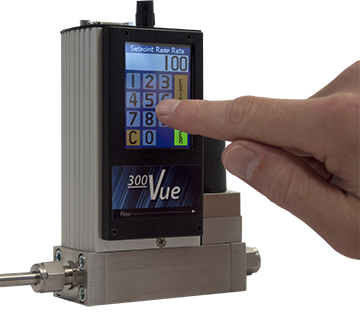A majority of flow instruments provide an analog output signal (0-5vdc, 4-20mA, etc.) that is directly proportional to the gas flow rate. System integrators can directly acquire this signal for process control.


If the installation is not configured for data acquisition, Teledyne Hastings offers convenient power supplies with integrated displays (see models THCD-101 and THCD-401 in image on right) and ready-to-use connector cables for quick start-up.
Some instruments offer digital communication to convey the flow rate, while other models have a built-in color touchscreen display (See model HFC-D-302B Vue in image on left)..
.
Just like any piece of instrumentation, it is important to read the product user manual prior to operation and to follow the mechanical and electrical connection procedures specified. Additionally, an electrical pinout reminder is found on the flow meter label. As with any flow device, ensure that mechanical flow connections are leak free.
For monitoring and control, some flow meter models offered by Teledyne Hastings have an optional built-in display and can operate using a commercial off-the-shelf AC/DC power convertor. For those models without integrated displays, Teledyne Hastings offers simple power supply/display controllers with installation-ready connection cables for straight-forward, out-of-the-box analog mass flow meter configuration.
It is recommended to allow the thermal mass flow meter to warm-up in order to achieve high accuracy. Additionally, after the flow meter has been allowed to warm up, it is recommended to zero the instrument prior to use.
Key Applications for Mass Flow Meters and Controllers
Common applications for mass flow instruments include but are not limited to:
-
Leak Testing
Historically, leak testing of components was accomplished using bubble tests, rotameters, and pressure decay tests (pressure loss over time). With the introduction of the mass flow meter, leak testing with air was faster, more accurate, and cleaner than other methods. This method has become the clear choice for high-throughput automation and have proven their reliability to leak test automotive and aircraft components, respirators, valves, medical devices, filtration media, and even hard disk drive enclosures.
-
Custody Transfer
When industrial gas from a common source is used in large facilities such as factories, universities, national laboratories, and hospitals, it is common to set up custody transfer flow meters. Flow meters used for custody transfer allow individual departments to monitor and be held accountable for their gas usage, as well as troubleshooting costly leaks and waste.
-
Environmental Monitoring
The exceptional accuracy of flow meters is a key part of the environmental monitoring processes. Flow meters allow monitoring equipment to calculate contamination levels in real time and because flow meters measure molecular flow, compensation for changes in ambient conditions are not necessary.
What is a Mass Flow Controller?
A mass flow controller is essentially a mass flow meter with a proportional control valve and a proportional integral derivative (PID) loop for controlling the valve. A mass flow controller not only measures the flow rate, but also allows the user to set and control that rate. The controller's proportional control valve continually adjusts position to achieve and maintain the desired flow rate, providing accurate, autonomous flow control.
FAQs
Q: Can Teledyne Hastings' flow meters be used with liquids or any fluid?
A: No. Teledyne Hastings' flow meters cannot be used with liquids. A fluid is defined as “a substance without a shape and can be either a gas or liquid". Fluids used in our flow meters must be in the gas phase (gases only).
Q: What is mass flow rate?
A: When measuring gases, mass flow rate is the amount of gas, measured in units of mass, flowing per units of time. Examples of true mass flow units are kg/hr and gm/sec. However, flow is often measured in standardized volumetric units.
Q: What is volumetric flow?
A: When measuring gases, volumetric flow is the amount of gas, measured in units of volume, flowing per unit time. Examples include l/s and cfm. Mass flow can be calculated from the volumetric flow rate only if the density (ρ) is known. Qmass = Qvol*ρ.
Q: What is standard temperature and pressure (STP)?
A: In standardized volumetric flow units (sccm, slm, scfm), the reference conditions, or “STP" pressure and temperature, define the quantity of gas by determining the number of molecules according to the Ideal Gas Law. This is not the same as gas temperature. In most cases, the selected reference conditions are 0°C & 760 Torr. But, other reference conditions are also used, such as 20°C & 760 Torr, or 70°F & 760 Torr.
Q: How frequently does a flow instrument require calibration?
A: While each individual user's quality manual will dictate calibration frequency requirements, it is fairly common to calibrate flow meters yearly. Teledyne Hastings has authorized calibration service centers in the United States, United Kingdom, South Korea, and China.
Q: Is a gas flow meter or controller safe to use with hydrogen and other flammable gases?
A: Yes. All Teledyne Hastings' flow meters are designed and tested for hermeticity (gas tight) and the bypass shunt and sensor gas path are isolated from all electronics to eliminate sources of ignition.

